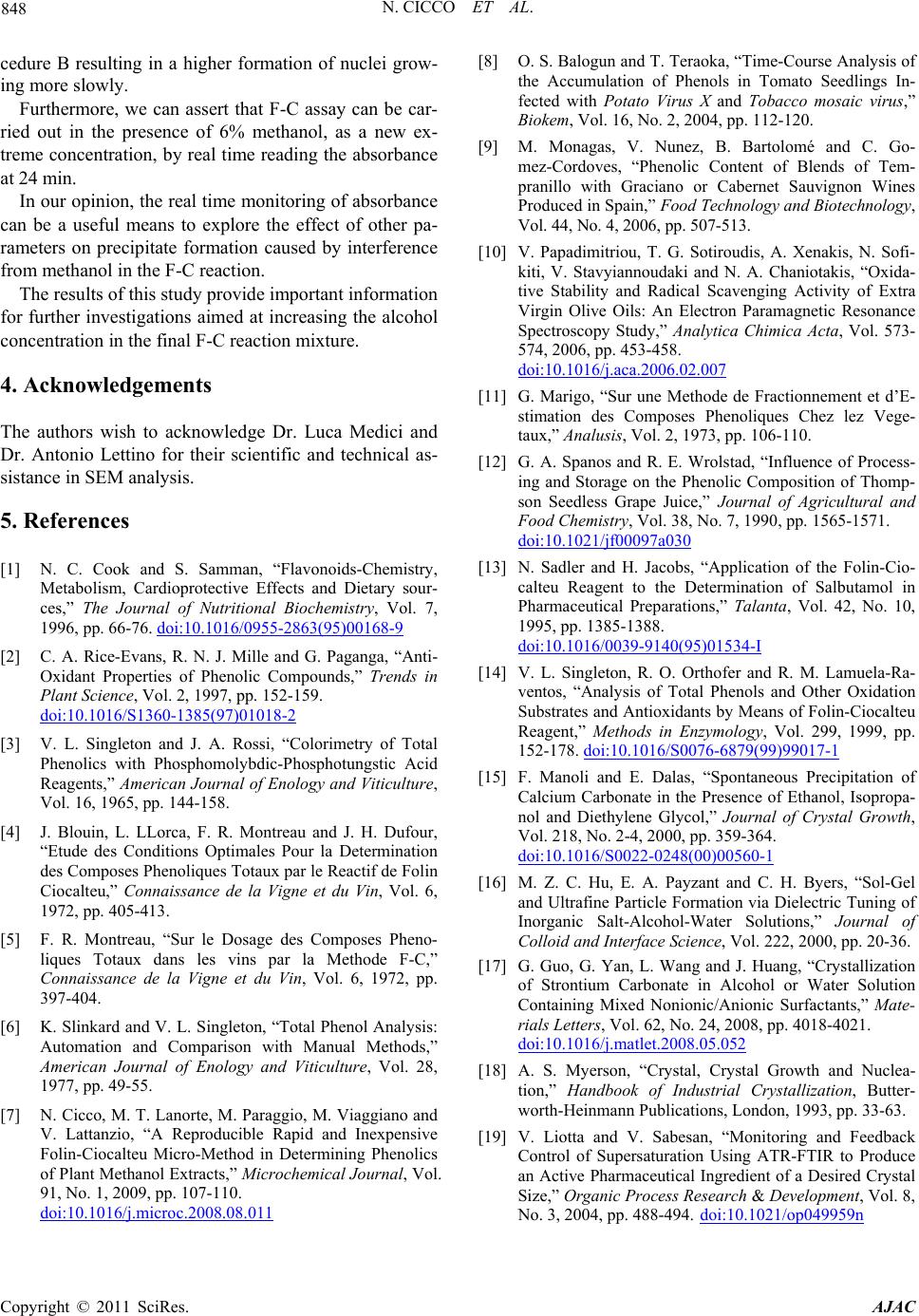
N. CICCO ET AL.
848
cedure B resulting in a higher formation of nuclei grow-
ing more slowly.
Furthermore, we can assert that F-C assay can be car-
ried out in the presence of 6% methanol, as a new ex-
treme concentration, by real time reading the absorbance
at 24 min.
In our opinion, the real time monitoring of absorbance
can be a useful means to explore the effect of other pa-
rameters on precipitate formation caused by interference
from methanol in the F-C reaction.
The results of this study provide important information
for further investigations aimed at increasing the alcohol
concentration in the final F-C reaction mixture.
4. Acknowledgements
The authors wish to acknowledge Dr. Luca Medici and
Dr. Antonio Lettino for their scientific and technical as-
sistance in SEM analysis.
5. References
[1] N. C. Cook and S. Samman, “Flavonoids-Chemistry,
Metabolism, Cardioprotective Effects and Dietary sour-
ces,” The Journal of Nutritional Biochemistry, Vol. 7,
1996, pp. 66-76. doi:10.1016/0955-2863(95)00168-9
[2] C. A. Rice-Evans, R. N. J. Mille and G. Paganga, “Anti-
Oxidant Properties of Phenolic Compounds,” Trends in
Plant Science, Vol. 2, 1997, pp. 152-159.
doi:10.1016/S1360-1385(97)01018-2
[3] V. L. Singleton and J. A. Rossi, “Colorimetry of Total
Phenolics with Phosphomolybdic-Phosphotungstic Acid
Reagents,” American Journal of Enology and Viticulture,
Vol. 16, 1965, pp. 144-158.
[4] J. Blouin, L. LLorca, F. R. Montreau and J. H. Dufour,
“Etude des Conditions Optimales Pour la Determination
des Composes Phenoliques Totaux par le Reactif de Folin
Ciocalteu,” Connaissance de la Vigne et du Vin, Vol. 6,
1972, pp. 405-413.
[5] F. R. Montreau, “Sur le Dosage des Composes Pheno-
liques Totaux dans les vins par la Methode F-C,”
Connaissance de la Vigne et du Vin, Vol. 6, 1972, pp.
397-404.
[6] K. Slinkard and V. L. Singleton, “Total Phenol Analysis:
Automation and Comparison with Manual Methods,”
American Journal of Enology and Viticulture, Vol. 28,
1977, pp. 49-55.
[7] N. Cicco, M. T. Lanorte, M. Paraggio, M. Viaggiano and
V. Lattanzio, “A Reproducible Rapid and Inexpensive
Folin-Ciocalteu Micro-Method in Determining Phenolics
of Plant Methanol Extracts,” Microchemical Journal, Vol.
91, No. 1, 2009, pp. 107-110.
doi:10.1016/j.microc.2008.08.011
[8] O. S. Balogun and T. Teraoka, “Time-Course Analysis of
the Accumulation of Phenols in Tomato Seedlings In-
fected with Potato Virus X and Tobacco mosaic virus,”
Biokem, Vol. 16, No. 2, 2004, pp. 112-120.
[9] M. Monagas, V. Nunez, B. Bartolomé and C. Go-
mez-Cordoves, “Phenolic Content of Blends of Tem-
pranillo with Graciano or Cabernet Sauvignon Wines
Produced in Spain,” Food Technology and Biotechnology,
Vol. 44, No. 4, 2006, pp. 507-513.
[10] V. Papadimitriou, T. G. Sotiroudis, A. Xenakis, N. Sofi-
kiti, V. Stavyiannoudaki and N. A. Chaniotakis, “Oxida-
tive Stability and Radical Scavenging Activity of Extra
Virgin Olive Oils: An Electron Paramagnetic Resonance
Spectroscopy Study,” Analytica Chimica Acta, Vol. 573-
574, 2006, pp. 453-458.
doi:10.1016/j.aca.2006.02.007
[11] G. Marigo, “Sur une Methode de Fractionnement et d’E-
stimation des Composes Phenoliques Chez lez Vege-
taux,” Analusis, Vol. 2, 1973, pp. 106-110.
[12] G. A. Spanos and R. E. Wrolstad, “Influence of Process-
ing and Storage on the Phenolic Composition of Thomp-
son Seedless Grape Juice,” Journal of Agricultural and
Food Chemistry, Vol. 38, No. 7, 1990, pp. 1565-1571.
doi:10.1021/jf00097a030
[13] N. Sadler and H. Jacobs, “Application of the Folin-Cio-
calteu Reagent to the Determination of Salbutamol in
Pharmaceutical Preparations,” Talanta, Vol. 42, No. 10,
1995, pp. 1385-1388.
doi:10.1016/0039-9140(95)01534-I
[14] V. L. Singleton, R. O. Orthofer and R. M. Lamuela-Ra-
ventos, “Analysis of Total Phenols and Other Oxidation
Substrates and Antioxidants by Means of Folin-Ciocalteu
Reagent,” Methods in Enzymology, Vol. 299, 1999, pp.
152-178. doi:10.1016/S0076-6879(99)99017-1
[15] F. Manoli and E. Dalas, “Spontaneous Precipitation of
Calcium Carbonate in the Presence of Ethanol, Isopropa-
nol and Diethylene Glycol,” Journal of Crystal Growth,
Vol. 218, No. 2-4, 2000, pp. 359-364.
doi:10.1016/S0022-0248(00)00560-1
[16] M. Z. C. Hu, E. A. Payzant and C. H. Byers, “Sol-Gel
and Ultrafine Particle Formation via Dielectric Tuning of
Inorganic Salt-Alcohol-Water Solutions,” Journal of
Colloid and Interface Science, Vol. 222, 2000, pp. 20-36.
[17] G. Guo, G. Yan, L. Wang and J. Huang, “Crystallization
of Strontium Carbonate in Alcohol or Water Solution
Containing Mixed Nonionic/Anionic Surfactants,” Mate-
rials Letters, Vol. 62, No. 24, 2008, pp. 4018-4021.
doi:10.1016/j.matlet.2008.05.052
[18] A. S. Myerson, “Crystal, Crystal Growth and Nuclea-
tion,” Handbook of Industrial Crystallization, Butter-
worth-Heinmann Publications, London, 1993, pp. 33-63.
[19] V. Liotta and V. Sabesan, “Monitoring and Feedback
Control of Supersaturation Using ATR-FTIR to Produce
an Active Pharmaceutical Ingredient of a Desired Crystal
Size,” Organic Process Research & Development, Vol. 8,
No. 3, 2004, pp. 488-494. doi:10.1021/op049959n
Copyright © 2011 SciRes. AJAC